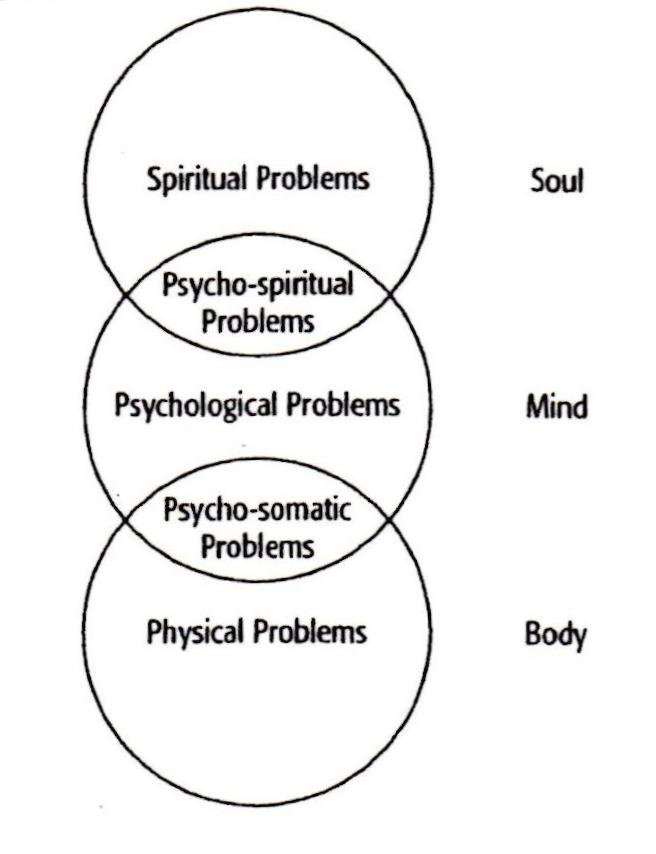Other Articles in this Series:
Part 1 – The Teachings of Sikhism
Part 2 – My Perspectives on Spirituality
Part 3 – Spirituality in Counseling and Psychotherapy
Part 5 – Spiritual Strategies of the Sikhs
Human Problems
Human problems can be broadly classified into three main categories. Namely, problems of the body, mind, and the soul. In addition, it can be pictorially shown that the human mind is capable of affecting both the body and the soul.

We are already aware of so called psychosomatic problems, when mind affects the body negatively or positively. But when mind affects the soul negatively, these problems become psycho-spiritual. Western psychology has already placed significant emphasis on somatic, psychosomatic and psychological problems, but the study of spiritual or psycho-spiritual problems is relatively very new. Many students have a mental block, when they are asked to define psycho-spiritual problems. When it comes to define spiritual problems, they even get more confused. To distinguish between psychological and spiritual problems, I propose to add the word “ultimate” to all words we use in psychology to express our negative feelings. For instance, fear becomes ultimate fear. Anxiety becomes ultimate anxiety, and guilt is changed to ultimate guilt. Adding ultimate to other words, we may call them positive words, as given below can also express our feelings about spirituality more adequately:
Ultimate + love = ultimate love
Ultimate +development = Ultimate development
Ultimate + sacrifice = ultimate sacrifice
As there are always some exceptions to the rule, I am sure that it might not work in some instance. It surely won’t work for those clients who have no faith in a Higher being or no interest in spiritual matters.
The Cause of Human Problems
From the perspective of Sikhism, all human problems have their roots in egocentrism. A person’s mind is generally self-serving. It is the mind that is the real culprit. Unbridled, it runs wild causing powerful emotions that dictate human behaviors. As previously discussed, kaam (lust), krodh (anger), lobh (greed), moh (worldly attachments), ahankar (haughtiness/pride) all are the root causes of problems and are themselves rooted in the mind. For this reason, Guru Nanak asserted that whoever can control the mind, can win the entire world. (Man jitay jag jeet. M.1. p. 6.)
Furthermore, Guru Nanak, when he wrote “Nanak dukhia sabh sansar (SGGS, p. 954.) pointed out that whole world is suffering.
Human suffering springs from a person becoming manmukh (egocentric) and going astray from the path of becoming Gurmukh (enlightened) by living in Dharma (harmony with the One in all.) Guru Nanak asserts, “Permasher te bhulian viappan sabhe rog.” “All human suffering is due to the forgetfulness of one’s True, Infinite Identity.” (Baran Majh Mohalla 5.)
I strongly believe that if properly understood, in the final analysis all psychological problems have their origin in spiritual emptiness. Ingersoll has proposed ten dimensions in his Spiritual Wellness Inventory (2001) including, “Conception of the Absolute/Divine, Meaning, Connectedness, Mystery, Spiritual Freedom, Experience/Ritual, Forgiveness, Hope, Knowledge/ Learning, and Present-Centeredness.”
An analysis of these dimensions of Ingersoll’s Spiritual Wellness Inventory can be used to demonstrate that “all problems are actually spiritual problems.” This means that a person’s problem can be traced back to, or is connected in some way to, a person’s spiritual well-being. For instance, without a feeling of connectedness a person would feel lonely, depressed, and isolated. Without mystery, a person would have no faith in life after death and a sense of ultimate anxiety will prevail. If a person does not possess the ability to forgive they will always feel guilt, remorse, and anger.
While it is not possible to discuss all ten dimensions here, it must be noted that when one spiritual dimension is in distress all others also suffer.
Experiential Stages of Spirituality
Frame (2003) discussed the work of five theorists who focused on the linear or hierarchical progress of people’s religious or faith development. These theorists included Gordon Allport’s Theory of Religious Sentiments (1950); James Fowler’s Stages of Faith Development (1981); Michael Washburn’s Stages of Psychospiritual Development (1988); Fritz Oser’s Stages of Religious Judgment (1991) and Genia’s Stages of Faith (1995.) All of these models are useful for counselors and psychotherapists as they provide a framework for understanding how clients develop religious or spiritual interests. These models also help counselors identify the critical transitional points where intervention strategies become imperative.
However, I have three major criticisms against these models. First, I don’t believe that spiritual development necessarily progresses in a linear fashion or in sequential stages as suggested in these models. I believe that spiritual maturity develops in a desultory manner. Secondly, most of these models seem to mirror Kohlberg’s Stages of Moral Development or Piaget’s Cognitive Development Stages (Gathman & Nessan, 1997.)
Since “experiencing is believing” in spirituality, I would argue that spiritual development is based more on social learning theory. Third, these models have confounded spirituality with religion. Spirituality and religion are presented as intertwined. I consider religion as a means to spirituality and therefore it needs to be discussed separately.
I conceptualize the following seven experiential stages of spirituality. Religion may or may not play role in them. I call these stages as the experience-based stages of spirituality (Sandhu & Asrabadi, in press). These stages are briefly introduced here:
The Experience-Based Stages of Spiritual Development
Stage 1: Scourge is a stage which can best be described as an aspiritual stage. At this level the individual is egocentric (manmukh) and is focused only on materialistic matters. Spirituality is of very little or no interest. I call life without spirituality, a scourge. In Gurbani it is called “dhrig,” a life of ingratitude. If life is a gift from God, not thinking about Him or worshipping Him is an inexcusable human act.
Stage 2: Emerge. In some cases, emerging from the previous stage of scourge results from a major life event or trauma, which leads a person to become spiritual. It seems that in time of crisis, most humans become religious or spiritual.
In other cases, an awakening to spiritual life might be sparked by a Guru. Of course, a Guru could be any person who removes our darkness or ignorance and introduces us to the spiritual realm. In the absence of a living Guru, a scripture can serve as the source of inspiration. This stage can be described as a transforming stage which can also be conducive to transitioning to higher stages. Spirituality becomes important for a person first time during this stage. A person takes deliberate interest in it.
Stage 3: Purge. Purge is characterized by an individual rejecting materialistic and worldly pleasures. At this level the individual changes their path. Spiritual concerns become more important than materialistic interests. A part of the purging process, may include turning away from a life of scourge and the friends one had in that stage. A person makes a conscious effort to manage the previously mentioned five deadly habits of lust, anger, greed, worldly attachments, and haughtiness as these are the barriers to spiritual life. During this stage, the people one choses to spend time with become very important. One chooses to be with people who inspire and up-level and do not judge, but are most likely at a similar stage of their own spiritual development.
Stage 4: Diverge. The ascent to walk a spiritual path is not steady or linear. A person might start experiencing divergence, by leaving their spiritual path and going back to old materialistic ways of living. There may be a loss of interest in spiritual matters during this stage. This set back is generally transitory.
Stage 5: Resurge. During the Resurgence stage individuals come back to a stronger, deeper spiritual understanding after having “slipped,” regressed, or a suffered loss of interest in their spiritual journey. This spiritual understanding and interest is stronger than previous experiences. At this stage spirituality and religion become important once again. One’s interest in spirituality is revived or renewed more vigorously.
Stage 6: Converge People experiencing convergence are firmly on their spiritual path. Their “spiritual beliefs, spiritual feelings, and spiritual actions,” are all in synchrony. A spiritual person starts living his or her life according to the principle for living as set forth by their scriptures, Dharma/path or by high moral standards. At this level, a person experiences a great solace and satisfaction by balancing both spiritual and materialistic matters in his or her life. Clearly, there is a comfort in walking on this path where there is faith, hope, and an appreciation for life.
Stage 7: Merge. The merge stage is the ultimate in spiritual development. There is emphasis on the experience of union with God or Oneness. This stage also has mystical qualities. This stage is characterized by one being consciously united with the One. It is described by the poet Walt Whitman in his Leaves of Grass (1900.)
“All goes onward and outward, nothing collapses,
And to die is different from what any one supposed, and luckier.
Has anyone supposed it lucky to be born?
I hasten to inform him or her it is just as lucky to die, and I know it.
I pass death with the dying and birth with the new-wash'd babe,
and am not contained between my hat and boots.”
In this state, life and death are both understood as blessings. Dukh sukh dono sam kar janey (SGGS, p. 219). At this highest stage of spiritual realization, suffering and comforts are one and the same. They both come from the One. At this stage a person sees and knows that every other person is one with him or herself.
Assessing Spirituality
A person’s stage on the spiritual journey can be identified by using, “Experience Based Spiritual Development Scale (EBSDS)” developed and empirically tested by Sandhu and Asrabadi (in press.) It must be noted that all persons have psychological or psychospiritual concerns at each of these stages, especially at the transition points. For instance, a sense of meaninglessness or spiritual emptiness will generally be prevalent at the scourge stage. A sense of spiritual emergency and depression is felt at the emergence stage. Leaving old behaviors and adopting a new spiritually oriented life style can be quite stressful. While diverging, it is natural to feel guilty. Resurgence could create some ambivalent feelings. The last two stages, “converge” and “merge” may create separation anxiety, caused by drift from material world to the spiritual realm.
Counselors are encouraged to use this scale, EBSDS, to determine the current spiritual stage(s) at which their clients are functioning. They also need to provide psychological or psycho-spiritual help relevant to their emotional needs.
Other Articles in this Series:
Part 1 – The Teachings of Sikhism
Part 2 – My Perspectives on Spirituality
Part 3 – Spirituality in Counseling and Psychotherapy
Part 5 – Spiritual Strategies of the Sikhs






